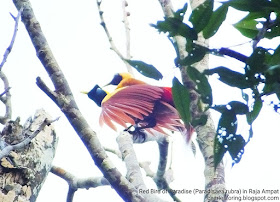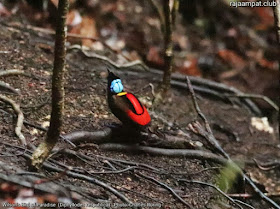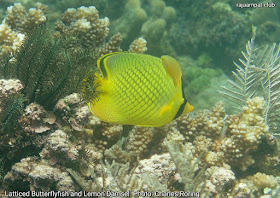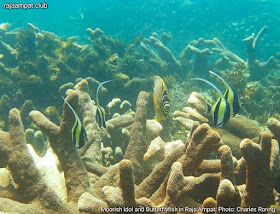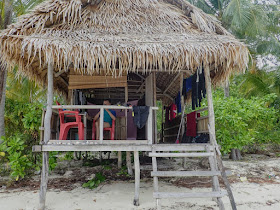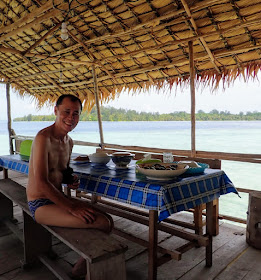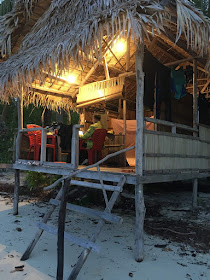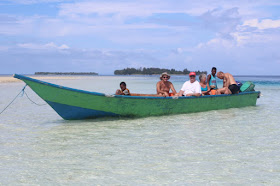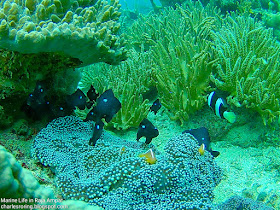 |
| Orange-skunk Anemonefish |
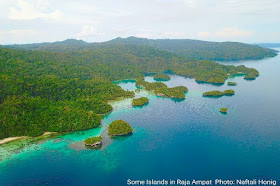 |
| Karst inside Kabui bay of Raja Ampat |
For those who want to explore the tropical rainforest in Raja Ampat, July is a perfect month. Orchids, tropical plants, reptiles, mammals, birds and insects can be seen while we walk in the jungle. As a tour guide, I organize birdwatching tour to Raja Ampat all year round, even in late June, July and September when the waves are big. There are a lot of birds that we can watch including Palm Cockatoo, Sulphur-crested Cockatoo, Eclectus Parrot, Great-billed Parrot, Violet-necked Lory, Red-cheeked Parrot, Spice Imperial Pigeon, Pinon Imperial Pigeon, Pied Imperial Pigeon, Hooded Butcherbird, Beach Kingfisher, Rufous-bellied Kookaburra, Common Paradise Kingfisher, Willie Wagtail, Torresian Crow, Pacific Swallow, White-breasted Woodswallow, Wimbrel, Brahminy Kite, White-belly Sea Eagle, and a lot more.
Birdwatching activity can be done using binoculars, and spotting scope.
Which places you could visit in July?
You could visit places in Raja Ampat that are not directly exposed to sea current and waves that come from south-east or south-west directions. So, doing land tours in Waigeo, Salawati or Batanta will be ok. However, transport vehicles are not always available especially for big boats that go to Salawati and Batanta. Regular passenger ferry go to Misool, and Waigeo. There are also ships that go to Kofiau. Coastal villages in northern region of Waigeo have got calm waters in July, August and September. It is a suitable place for swimming, fishing, and wildlife watching in the forest.
Birdwatching activity can be done using binoculars, and spotting scope.
 |
| North coast of Wageo |
You could visit places in Raja Ampat that are not directly exposed to sea current and waves that come from south-east or south-west directions. So, doing land tours in Waigeo, Salawati or Batanta will be ok. However, transport vehicles are not always available especially for big boats that go to Salawati and Batanta. Regular passenger ferry go to Misool, and Waigeo. There are also ships that go to Kofiau. Coastal villages in northern region of Waigeo have got calm waters in July, August and September. It is a suitable place for swimming, fishing, and wildlife watching in the forest.
After your trip to Raja Ampat, you could extend your holiday in Sorong city to explore its mangrove forest, rainforest to watch wildlife, city life, traditional market.
Booking
The spread of Covid-19 around the world is still going on. If the threat of this virus has stopped and tourism activities can be continued again, anyone will be allowed to visit Raja Ampat again.
If you are interested in traveling to Raja Ampat and want me to organize your tour and accompany you, please, contact me (Charles Roring) by e-mail to: peace4wp@gmail.com or by whatsapp to: +6281332245180
Also read:
Raja Ampat Birds
Snorkeling and Watching Birds of Paradise in Raja Ampat
Raja Ampat beach
Booking
The spread of Covid-19 around the world is still going on. If the threat of this virus has stopped and tourism activities can be continued again, anyone will be allowed to visit Raja Ampat again.
If you are interested in traveling to Raja Ampat and want me to organize your tour and accompany you, please, contact me (Charles Roring) by e-mail to: peace4wp@gmail.com or by whatsapp to: +6281332245180
Also read:
Raja Ampat Birds
Snorkeling and Watching Birds of Paradise in Raja Ampat
Raja Ampat beach




